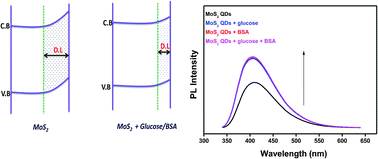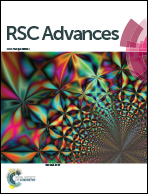Optical and surface band bending mediated fluorescence sensing properties of MoS2 quantum dots†
Abstract
We report the photoluminescence sensing of glucose and bovine serum albumin (BSA) biomolecules using molybdenum disulfide quantum dots (MoS2 QDs). Polydispersed MoS2 QDs of size 2.8–4.2 nm is synthesized by hydrothermal method. The prepared MoS2 QDs exhibit very strong blue luminescence under ultraviolet (UV) excitation. The emission wavelength gets red shifted as the excitation wavelength varies from 250 to 510 nm, which shows the polydispersed nature of the prepared QDs. Glucose and BSA sensing property of the prepared QDs are studied by the photoluminescence sensing method. Increasing glucose and BSA concentrations (nM level) in the MoS2 QDs show enhanced blue emission. Mechanism for enhanced photoluminescence is explained using surface band bending effect. The change in concentration of biomolecules versus change in photoluminescence intensity of the prepared MoS2 QDs shows linear response and is fitted by regression line equation. The results demonstrate the surface band bending assisted fluorescence sensing properties of the prepared MoS2 QDs and can be appropriate for glucose and BSA sensing applications.


 Please wait while we load your content...
Please wait while we load your content...